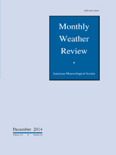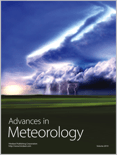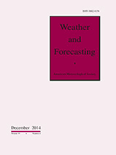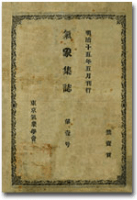
MONTHLY WEATHER REVIEW
Scope & Guideline
Fostering Innovation in Meteorological Research
Introduction
Aims and Scopes
- Atmospheric Modeling and Simulation:
The journal emphasizes research on various atmospheric models, including numerical weather prediction models and high-resolution simulations, which are essential for understanding and predicting weather patterns. - Data Assimilation Techniques:
MWR publishes studies focused on data assimilation methods, integrating observational data into models to improve forecast accuracy and understanding of atmospheric processes. - Severe Weather Analysis:
Research on severe weather phenomena, including tornadoes, hurricanes, and thunderstorms, is a core focus, providing insights into their characteristics, formation, and impacts. - Climate Variability and Change:
The journal covers studies related to climate variability, including the impacts of phenomena like El Niño and La Niña on weather patterns, as well as long-term climate change effects. - Remote Sensing and Observational Studies:
MWR encourages research that utilizes satellite and radar data to observe and analyze weather systems, providing valuable insights into atmospheric dynamics. - Machine Learning and Artificial Intelligence Applications:
The journal is increasingly publishing studies that apply machine learning and AI techniques in meteorology, enhancing predictive capabilities and data analysis.
Trending and Emerging
- Ensemble Forecasting Techniques:
Recent publications indicate a significant increase in research on ensemble forecasting methods, which provide probabilistic forecasts and help quantify uncertainty in weather predictions. - Advanced Data Assimilation Methods:
There is a growing focus on sophisticated data assimilation techniques, including hybrid approaches that combine ensemble and variational methods to enhance model performance. - Impacts of Urbanization on Weather Patterns:
Emerging studies are increasingly addressing the effects of urbanization on local weather phenomena, reflecting a broader interest in understanding how cities influence climate and weather. - Climate Change Impacts on Extreme Weather:
Research examining the connections between climate change and the frequency/intensity of extreme weather events is gaining traction, highlighting the urgency of understanding these relationships. - Machine Learning in Meteorology:
The integration of machine learning techniques in weather forecasting, data analysis, and model improvement is a rapidly growing area, showcasing the journal's commitment to innovation in atmospheric research. - Tropical Cyclone Dynamics:
There is a notable trend towards in-depth studies of tropical cyclones, including their formation, intensification, and interaction with environmental factors, reflecting ongoing concerns about their impacts.
Declining or Waning
- Traditional Statistical Methods:
There is a noticeable decrease in the publication of studies relying solely on traditional statistical methods for weather forecasting, as newer, data-driven techniques gain prominence. - Deterministic Forecasting Models:
Research focusing exclusively on deterministic models without incorporating probabilistic approaches is becoming less common, reflecting a shift towards ensemble and probabilistic forecasting. - Historical Weather Events Analysis:
While historical analysis remains relevant, there has been a decline in papers solely dedicated to retrospective studies of past weather events, as the focus shifts more towards predictive modeling. - Simplistic Climate Models:
There is a waning interest in studies that employ overly simplistic climate models that do not account for complex interactions within the atmosphere, as more comprehensive models are preferred.
Similar Journals

TELLUS SERIES A-DYNAMIC METEOROLOGY AND OCEANOGRAPHY
Elevating Understanding of Dynamic Earth SystemsTELLUS SERIES A-DYNAMIC METEOROLOGY AND OCEANOGRAPHY, published by Stockholm University Press, is a prestigious open-access journal that has been at the forefront of research in the fields of atmospheric science and oceanography since its inception in 1983. With an enduring commitment to disseminating high-quality, peer-reviewed research, the journal has achieved a commendable impact factor, securing its position in the Q2 category for both Atmospheric Science and Oceanography as of 2023. The journal's significant reach is reflected in its Scopus rankings, being positioned at Rank #51 in Oceanography and Rank #77 in Atmospheric Science. With open access established since 2012, TELLUS SERIES A serves not only as a vital resource for researchers and professionals in these dynamic fields but also as an inclusive platform for budding scholars and students. Engaging with this journal allows readers to stay updated on the latest developments and groundbreaking discoveries that advance our understanding of climate systems and marine environments. Its editorial ethos emphasizes the cross-disciplinary integration of atmospheric and oceanographic studies, making it an essential publication for anyone invested in environmental research and policy.

Weather
Illuminating the Dynamics of Weather and ClimateWeather is a prestigious academic journal published by WILEY, specializing in the field of Atmospheric Science. Since its inception in 1946, the journal has emerged as a key resource for researchers, professionals, and students seeking to deepen their understanding of meteorological phenomena and climate dynamics. Weather is recognized for its robust impact within the scientific community, boasting a 2023 Scopus ranking of 96 out of 148 in the Earth and Planetary Sciences category, placing it comfortably within the Q2 category. Although it does not offer open access options, the journal is committed to publishing high-quality, peer-reviewed articles that advance the knowledge base of atmospheric sciences up to 2024. Through its diverse range of research, reviews, and case studies, Weather continues to play a vital role in facilitating discussions and discoveries in this essential field of study.

Advances in Meteorology
Transforming Weather Insights into Actionable KnowledgeAdvances in Meteorology is a renowned open-access journal published by Hindawi Ltd, dedicated to the dynamic field of meteorology and related atmospheric sciences. Since its inception in 2009, this journal has served as a vital platform for researchers and professionals, facilitating the dissemination of cutting-edge research that advances our understanding of atmospheric phenomena. With a commendable impact in the realms of Geophysics, Atmospheric Science, and Environmental Pollution, it boasts impressive Scopus rankings—34th percentile in Geophysics, 54th in Atmospheric Science, and 61st in Environmental Pollution—highlighting its significance and relevance in these critical areas. The journal's commitment to open access ensures that vital research reaches a wide audience, fostering collaboration and innovation within the scientific community. Positioned with a mix of rigorous research and interdisciplinary approaches, Advances in Meteorology continues to shape the landscape of atmospheric science research from its base in Egypt, addressing pressing global challenges related to climate and environment.

Tethys-Journal of Mediterranean Meteorology & Climatology
Enhancing Understanding of Regional Climate ChallengesTethys - Journal of Mediterranean Meteorology & Climatology, published by the Associació Catalana de Meteorologia (ACAM), serves as a specialized platform dedicated to advancing the study of meteorological and climatological phenomena within the Mediterranean region. With a Scopus Rank of #94 out of 148 in the field of Atmospheric Science, this journal is positioned in the Q4 category, reflecting a growing recognition among researchers focused on regional climate variations and environmental challenges. Established in 2012 and publishing through 2023, Tethys aims to provide open access to high-quality research articles that address critical issues impacting climate and weather patterns, thus contributing to a deeper understanding of Mediterranean meteorology. The journal’s mission aligns closely with the increasing global emphasis on climate studies and serves as an essential resource for academics, practitioners, and students dedicated to sustainably addressing the environmental and climatic challenges faced by this diverse and dynamic region.

WEATHER AND FORECASTING
Your Gateway to Cutting-Edge Meteorological ResearchWeather and Forecasting is a premier journal published by the American Meteorological Society, focusing on cutting-edge research in the field of atmospheric science. With its ISSN 0882-8156 and E-ISSN 1520-0434, the journal has distinguished itself within the scientific community, holding a Q1 ranking in Atmospheric Science for 2023 and ranking #56 out of 148 in the Scopus Earth and Planetary Sciences category, demonstrating its influence and high-quality content. Since its inception in 1992, Weather and Forecasting has been dedicated to advancing knowledge in meteorology through rigorous peer-reviewed articles that span a wide range of topics—from numerical weather prediction to climate impacts and atmospheric dynamics. While the journal is not open access, it remains accessible to a broad audience through institutional subscriptions, reinforcing its role as a vital resource for researchers, practitioners, and students alike. With a commitment to excellence in scholarship and a vision towards the future, this journal plays a significant role in shaping the understanding of weather phenomena and forecasting methodologies.

JOURNAL OF THE METEOROLOGICAL SOCIETY OF JAPAN
Unlocking Insights into Weather and Climate DynamicsJournal of the Meteorological Society of Japan, ISSN 0026-1165 (E-ISSN 2186-9057), is a leading academic journal published by the Meteorological Society of Japan, dedicated to advancing the field of atmospheric sciences. Established in 1905, the journal has a long-standing tradition of publishing high-quality research that contributes to our understanding of meteorology, climatology, and environmental science. As an Open Access journal since 2018, it ensures wide dissemination of knowledge, allowing researchers, professionals, and students to access cutting-edge studies without barriers. With an impressive impact factor and ranked in the Q1 category in Atmospheric Science, it is recognized for its significant contributions, currently holding a Scopus rank of #36 out of 148 in the field. The journal serves as a vital resource for those involved in meteorological research, policy-making, and education, fostering collaboration and innovation within and beyond Japan.

Weather and Climate Dynamics
Connecting Science and Society through Climate ResearchWeather and Climate Dynamics, an esteemed journal published by COPERNICUS GESELLSCHAFT MBH, focuses on the intricate relationships and processes governing climate and weather patterns, advancing our understanding of atmospheric sciences. Since its launch in 2020, this Open Access journal has rapidly gained recognition, achieving a commendable Q1 status in Atmospheric Science and ranking 39th out of 148 journals in the Earth and Planetary Sciences category, placing it in the 73rd percentile. Based in Germany, the journal aims to provide a platform for innovative research, sharing crucial findings that contribute to tackling global climate challenges. Researchers, professionals, and students alike are encouraged to explore the wealth of knowledge contained within its pages, as it continues to shape the discourse on weather and climate dynamics through rigorous and impactful scholarship.

Asia-Pacific Journal of Atmospheric Sciences
Connecting Scholars Across the Asia-Pacific RegionWelcome to the Asia-Pacific Journal of Atmospheric Sciences, a leading publication in the field of atmospheric science, published by the Korean Meteorological Society. With an ISSN of 1976-7633 and an E-ISSN of 1976-7951, this journal has been a cornerstone for researchers and practitioners in the atmospheric sciences since its inception in 2008. Recognized for its rigorous peer-reviewed articles, it holds a commendable Q2 quartile ranking in 2023 and is placed at the 51st rank out of 148 in the Earth and Planetary Sciences, reflecting its impact within the community with a 65th percentile. The journal features a broad scope encompassing meteorology, climatology, and environmental sciences, making it an essential resource for scholars and industry experts alike. As an open access journal, it ensures that groundbreaking research is widely accessible, fostering collaboration and innovation across the Asia-Pacific region and beyond. Explore the latest findings and advancements in atmospheric sciences and contribute to the dynamic field of climate research through the journal's engaging content.

Journal of Operational Meteorology
Connecting Theory and Practice in Operational MeteorologyJournal of Operational Meteorology, published by the Natl Weather Assoc, is a pivotal resource in the intersecting fields of atmospheric science, computer science in earth sciences, and management science and operations research. With an ISSN of 2325-6184, this journal has established itself as a key player in operational meteorology, driving advancements in weather forecasting, climate modeling, and meteorological applications. Since its inception in 2019, it has garnered attention in various quartiles, ranking Q2 in both computers in earth sciences and management science categories, and Q3 in atmospheric science, indicating its growing influence in these disciplines. Researchers and practitioners alike benefit from its curated access to innovative methodologies, case studies, and theoretical insights that are crucial for advancing meteorological practices. Though it is currently not open access, the journal remains committed to disseminating essential research that informs both academic inquiry and practical application in the ever-evolving landscape of meteorology. With its base in the United States, the Journal of Operational Meteorology continues to attract contributions that reflect the latest trends and challenges in weather and climate research, making it an indispensable tool for those engaged in these vital studies.

METEOROLOGY AND ATMOSPHERIC PHYSICS
Fostering Discoveries in Weather and Climate StudiesMETEOROLOGY AND ATMOSPHERIC PHYSICS is a premier journal published by SPRINGER WIEN, dedicated to advancing the study of atmospheric phenomena and weather-related sciences. With an ISSN of 0177-7971 and an E-ISSN of 1436-5065, the journal has established itself as an important contributor in the field, particularly noted for its contributions in atmospheric science, holding a Q3 ranking in the 2023 category quartiles. Covering a wide array of topics from meteorological modeling to the physics of the atmosphere, it serves researchers, professionals, and students alike, facilitating the dissemination of significant findings and innovative research. The journal’s acceptance of articles until 2024 encourages a continuous influx of knowledge, and despite its lack of Open Access, it plays a crucial role in enriching the academic landscape for those engaged in Earth and planetary sciences, holding a commendable rank of 78 out of 148 in Scopus. Located in the scenic city of Vienna, Austria, the journal is positioned to harness the vibrancy of the academic community, providing a platform for valuable insights that can drive forward the field of meteorology and atmospheric physics.